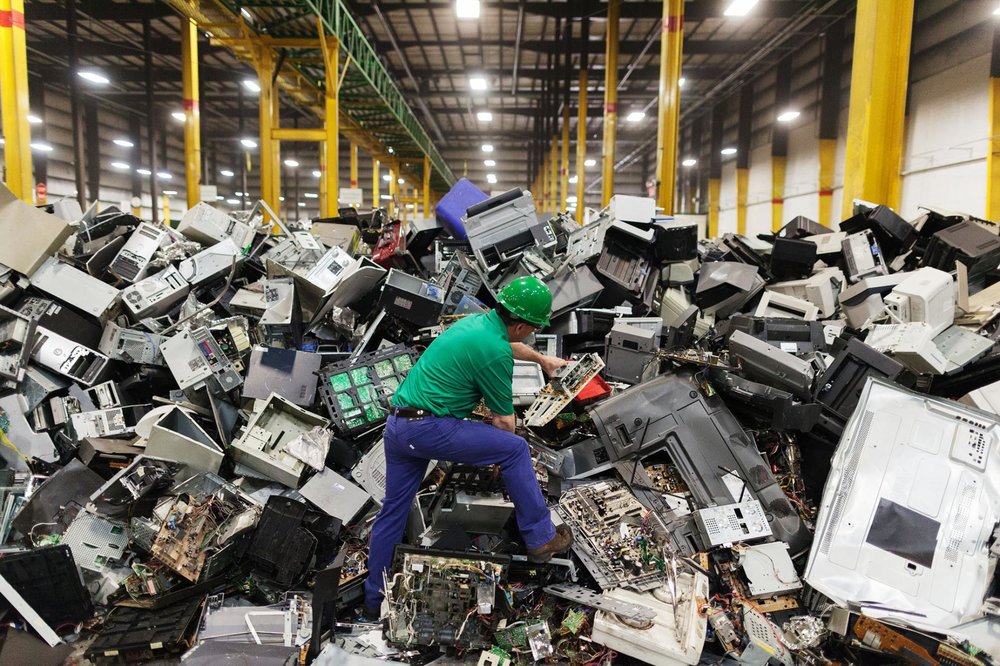‘Each Iranian generates 8kg of e-waste annually’

TEHRAN – Some 8 kilogram of electronic waste per person is produced annually in Iran, which causes serious health problems in case of being left untreated, a knowledge based company director has said.
Unfortunately, the leachate produced from the e-waste penetrates into the soil and pollutes ground water with harmful toxic substances, ISNA quoted Hamed Mazandarani as saying on Saturday.
“E-waste accounts for 2 percent of the total waste generated in the country,” Mazandarani added.
Each Iranian annually generates 8 kg of electronic waste which includes mobile phones, laptops, tablets, desktop computers, refrigerators, microwaves, televisions, washing machines and dishwashers, he noted.
In Iran the government emerges as the largest e-waste producer in the country, and according to the law, the state-run organizations are required to scrap the equipment after they have been out of order and put it out to tender, so the consequences of producing and leaving a large amount of e-waste is not considered seriously enough, he further explained.
“So, I have started studying national urban waste recycling for 15 years, as well as waste disposal systems of China, Japan, Belgium, and Germany and decided to change the condition by the idea of recycling all electronic wastes generated by the public sector,” Mazandarani said.
“To do so the waste management working group at each province has obliged all state-run organizations to deliver their electronic wastes to our company to be recycled at Imam Khomeini incubator,” he added.
Waste collectors are exposed to e-waste-derived chemicals in their daily life due to unsafe recycling activities, such as burning the electronic boards, as its ash containing lead, mercury and heavy metals pollutes soil and air, he regretted, adding that “we should employ the standard processes of collecting, disassembling, repairing and recycling the components or metals contained in discarded electronic equipment.”
Mazandarani said his company’s e-waste recycling techniques are also highly efficient in protecting information of the governmental agencies.
How E-waste becomes a major health threat
E-waste is a term used to cover all items of electrical and electronic equipment (EEE) and its parts that have been discarded by its owner as waste without the intent of re-use. E-waste includes a wide range of products – almost any household or business item with circuitry or electrical components with power or battery supply.
With the usage of electrical and electronic equipment (EEE) on the rise, the amount of electrical and electronic waste produced each day is equally growing enormously around the globe. Recycling of valuable elements contained in e-waste such as copper and gold has become a source of income mostly in the informal sector of developing or emerging industrialized countries. However, primitive recycling techniques such as burning cables for retaining the inherent copper expose both adult and child workers to a range of hazardous substances.
E-waste-connected health risks may result from direct contact with harmful materials such as lead, cadmium, chromium, brominated flame retardants or polychlorinated biphenyls (PCBs), from inhalation of toxic fumes, as well as from accumulation of chemicals in soil, water and food. In addition to its hazardous components, being processed, e-waste can give rise to a number of toxic by-products likely to affect human health. Furthermore, recycling activities such as dismantling of electrical equipment may potentially bear an increased risk of injury.
Children are especially vulnerable to the health risks that may result from e-waste exposure and, therefore, need more specific protection. As they are still growing, children’s intake of air, water and food in proportion to their weight is significantly increased compared to adults, and with that, the risk of hazardous chemical absorption. Furthermore, their bodies’ functional systems such as the central nervous, immune, reproductive and digestive system are still developing and exposure to toxic substances, by hampering further development, may cause irreversible damage.
During the last few years, various international calls for action have highlighted the need of strategic interventions in the field of e-waste. These include the Libreville Declaration emanating from the first Inter-Ministerial Conference on Health and Environment in Africa 2008, the Strategic Approach to Integrated Chemical Management’s expanded Global Plan of Action issued at the International Conference on Chemical Management ICCM3 in 2012 and the Busan Pledge for Action on Children’s Environmental Health of 2009. Currently, a few number of international initiatives are addressing global e-waste management and trade concerns, as well as issues with environmental pollution due to e-waste.
E-waste world's growing crisis
According to the UN's Step initiative [set up to tackle the world's growing e-waste crisis], last year, nearly 50m tones of e-waste was generated worldwide, or about 7kg per person on the planet. The global volume of electronic waste is expected to grow by 33 percent in the next four years, when it will weigh the equivalent of eight of the great Egyptian pyramids.
According to the Step report, e-waste is now the world's fastest growing waste stream. only 20 percent of e-waste was properly recycled in 2016. The vast majority (80 percent) was undocumented, likely to be dumped, traded or recycled under inferior conditions.
According to The Global E-waste Monitor, a report published by the United Nations University, only 20 percent of e-waste was properly recycled in 2016. The vast majority (80 percent) was undocumented, likely to be dumped, traded or recycled under inferior conditions.
China and the United States generated the highest amount of e-waste last year by 7.2 and 6.3 million tons per annum, respectively. However, it needs to be noted that neither the U.S. nor China stand out negatively in terms of per-capita waste generation compared to countries with similar living standards.
FB/MQ
Leave a Comment